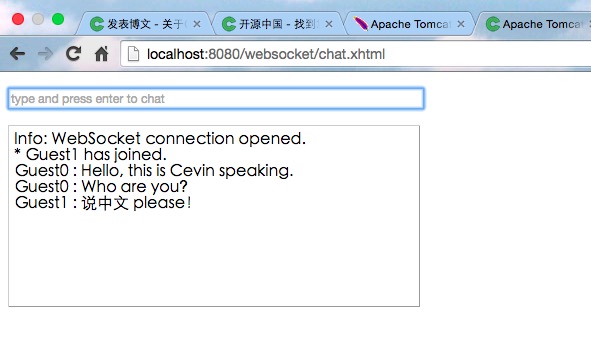标签:
知道WebSocket挺久了,但是一直没提起兴趣去了解它。
今天听@成熟的毛毛虫 说到slack。小小的试用了一下,发现slack的聊天功能做得相当强大,看了下网络请求,发现是基于WebSocket实现的。顿时提起兴趣,想了解下这强大的WebSocket。
先了解下WebSocket。
网上关于WebSocket的例子貌似不多,但最好的例子已经有了。偶然间发现tomcat的自带的例子中,已经有了基于WebSocket实现的聊天室例子。这里就不献丑,直接拿来用了。
首先,服务端的实现ChatAnnotation.java
/*
* Licensed to the Apache Software Foundation (ASF) under one or more
* contributor license agreements. See the NOTICE file distributed with
* this work for additional information regarding copyright ownership.
* The ASF licenses this file to You under the Apache License, Version 2.0
* (the "License"); you may not use this file except in compliance with
* the License. You may obtain a copy of the License at
*
* http://www.apache.org/licenses/LICENSE-2.0
*
* Unless required by applicable law or agreed to in writing, software
* distributed under the License is distributed on an "AS IS" BASIS,
* WITHOUT WARRANTIES OR CONDITIONS OF ANY KIND, either express or implied.
* See the License for the specific language governing permissions and
* limitations under the License.
*/
package websocket.chat;
import java.io.IOException;
import java.util.Set;
import java.util.concurrent.CopyOnWriteArraySet;
import java.util.concurrent.atomic.AtomicInteger;
import javax.websocket.OnClose;
import javax.websocket.OnError;
import javax.websocket.OnMessage;
import javax.websocket.OnOpen;
import javax.websocket.Session;
import javax.websocket.server.ServerEndpoint;
@ServerEndpoint(value = "/chat")
public class ChatAnnotation {
private static final String GUEST_PREFIX = "Guest";
private static final AtomicInteger connectionIds = new AtomicInteger(0);
private static final Set<ChatAnnotation> connections =
new CopyOnWriteArraySet<>();
private final String nickname;
private Session session;
public ChatAnnotation() {
nickname = GUEST_PREFIX + connectionIds.getAndIncrement();
}
@OnOpen
public void start(Session session) {
this.session = session;
connections.add(this);
String message = String.format("* %s %s", nickname, "has joined.");
broadcast(message);
}
@OnClose
public void end() {
connections.remove(this);
String message = String.format("* %s %s",
nickname, "has disconnected.");
broadcast(message);
}
@OnMessage
public void incoming(String message) {
// Never trust the client
// TODO: 过滤输入的内容
broadcast(message);
}
@OnError
public void onError(Throwable t) throws Throwable {
System.out.println("Chat Error: " + t.toString());
}
private static void broadcast(String msg) {
for (ChatAnnotation client : connections) {
try {
synchronized (client) {
client.session.getBasicRemote().sendText(msg);
}
} catch (IOException e) {
System.out.println("Chat Error: Failed to send message to client");
connections.remove(client);
try {
client.session.close();
} catch (IOException e1) {
// Ignore
}
String message = String.format("* %s %s",
client.nickname, "has been disconnected.");
broadcast(message);
}
}
}
}
稍微解释下上面这段代码。
客户端的实现chat.xhtml
<?xml version="1.0" encoding="UTF-8"?>
<!--
Licensed to the Apache Software Foundation (ASF) under one or more
contributor license agreements. See the NOTICE file distributed with
this work for additional information regarding copyright ownership.
The ASF licenses this file to You under the Apache License, Version 2.0
(the "License"); you may not use this file except in compliance with
the License. You may obtain a copy of the License at
http://www.apache.org/licenses/LICENSE-2.0
Unless required by applicable law or agreed to in writing, software
distributed under the License is distributed on an "AS IS" BASIS,
WITHOUT WARRANTIES OR CONDITIONS OF ANY KIND, either express or implied.
See the License for the specific language governing permissions and
limitations under the License.
-->
<html xmlns="http://www.w3.org/1999/xhtml" xml:lang="en">
<head>
<title>Apache Tomcat WebSocket Examples: Chat</title>
<style type="text/css"><![CDATA[
input#chat {
width: 410px
}
#console-container {
width: 400px;
}
#console {
border: 1px solid #CCCCCC;
border-right-color: #999999;
border-bottom-color: #999999;
height: 170px;
overflow-y: scroll;
padding: 5px;
width: 100%;
}
#console p {
padding: 0;
margin: 0;
}
]]></style>
<script type="application/javascript"><![CDATA[
"use strict";
var Chat = {};
Chat.socket = null;
Chat.connect = (function(host) {
if (‘WebSocket‘ in window) {
Chat.socket = new WebSocket(host);
} else if (‘MozWebSocket‘ in window) {
Chat.socket = new MozWebSocket(host);
} else {
Console.log(‘Error: WebSocket is not supported by this browser.‘);
return;
}
Chat.socket.onopen = function () {
Console.log(‘Info: WebSocket connection opened.‘);
document.getElementById(‘chat‘).onkeydown = function(event) {
if (event.keyCode == 13) {
Chat.sendMessage();
}
};
};
Chat.socket.onclose = function () {
document.getElementById(‘chat‘).onkeydown = null;
Console.log(‘Info: WebSocket closed.‘);
};
Chat.socket.onmessage = function (message) {
Console.log(message.data);
};
});
Chat.initialize = function() {
if (window.location.protocol == ‘http:‘) {
Chat.connect(‘ws://‘ + window.location.host + ‘/websocket/chat‘);
} else {
Chat.connect(‘wss://‘ + window.location.host + ‘/websocket/chat‘);
}
};
Chat.sendMessage = (function() {
var message = document.getElementById(‘chat‘).value;
if (message != ‘‘) {
Chat.socket.send(message);
document.getElementById(‘chat‘).value = ‘‘;
}
});
var Console = {};
Console.log = (function(message) {
var console = document.getElementById(‘console‘);
var p = document.createElement(‘p‘);
p.style.wordWrap = ‘break-word‘;
p.innerHTML = message;
console.appendChild(p);
while (console.childNodes.length > 25) {
console.removeChild(console.firstChild);
}
console.scrollTop = console.scrollHeight;
});
Chat.initialize();
document.addEventListener("DOMContentLoaded", function() {
// Remove elements with "noscript" class - <noscript> is not allowed in XHTML
var noscripts = document.getElementsByClassName("noscript");
for (var i = 0; i < noscripts.length; i++) {
noscripts[i].parentNode.removeChild(noscripts[i]);
}
}, false);
]]></script>
</head>
<body>
<div class="noscript"><h2 style="color: #ff0000">Seems your browser doesn‘t support Javascript! Websockets rely on Javascript being enabled. Please enable
Javascript and reload this page!</h2></div>
<div>
<p>
<input type="text" placeholder="type and press enter to chat" id="chat" />
</p>
<div id="console-container">
<div id="console"/>
</div>
</div>
</body>
</html>
客户端的代码也是很简单,就是载入页面的时候,创建跟服务器的WebSocket连接。
Chat.connect(‘ws://‘ + window.location.host + ‘/websocket/chat‘);
然后就是发送信息,接收信息了。
完成上述代码之后,就可以部署了。这里我使用的servlet容器是tomcat 8。以下是我的配置:
<Context path="/websocket" docBase="/Users/cevin/Documents/workspace/tomcat_websocket_chat/web" reloadable="true"/>
部署结束,启动tomcat,访问:http://localhost:8080/websocket/chat.xhtml,见到下面这个页面,说明部署成功了。

基本上,通过这个例子就可以知道如何使用WebSocket来进行开发了。这么强大的WebSocket,想一想都觉得兴奋!
标签:
原文地址:http://my.oschina.net/cevin15/blog/382582